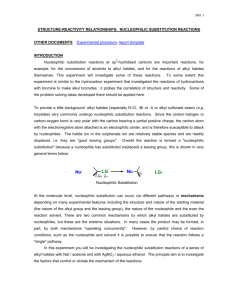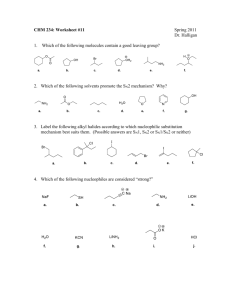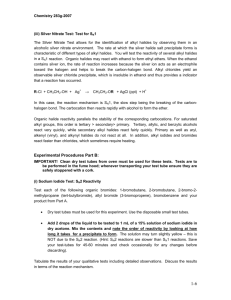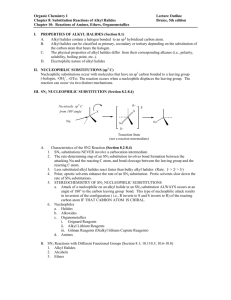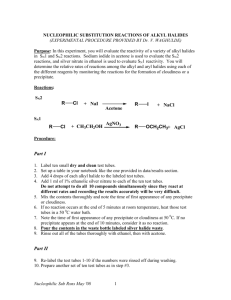Halogeno-compounds
advertisement
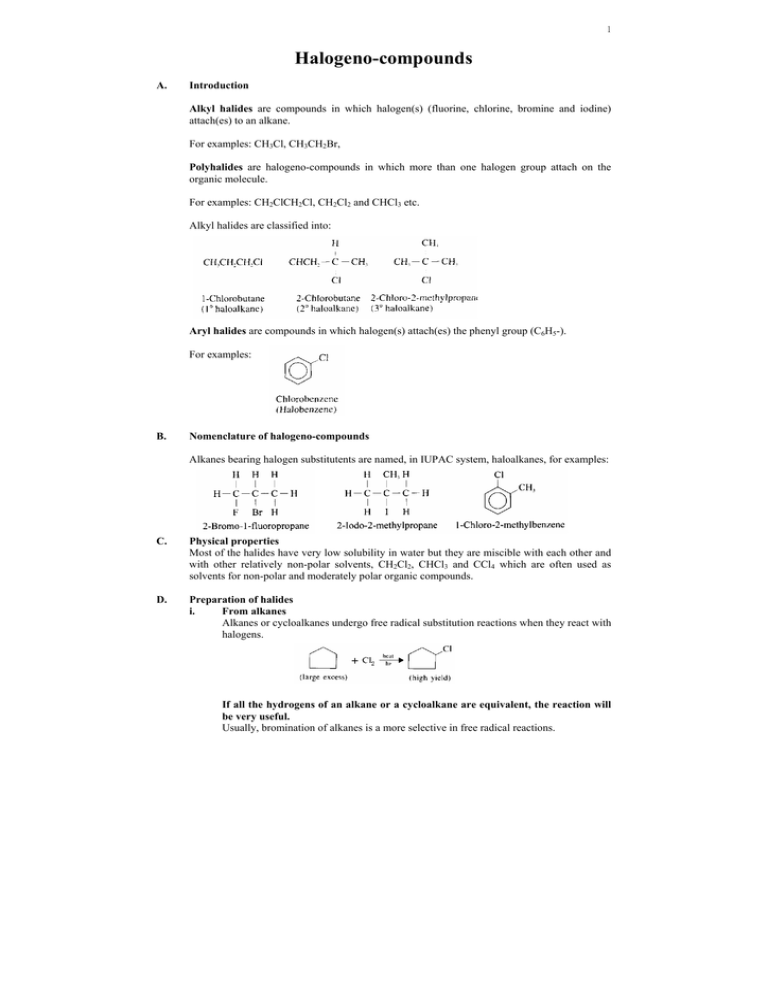
1 Halogeno-compounds A. Introduction Alkyl halides are compounds in which halogen(s) (fluorine, chlorine, bromine and iodine) attach(es) to an alkane. For examples: CH3Cl, CH3CH2Br, Polyhalides are halogeno-compounds in which more than one halogen group attach on the organic molecule. For examples: CH2ClCH2Cl, CH2Cl2 and CHCl3 etc. Alkyl halides are classified into: Aryl halides are compounds in which halogen(s) attach(es) the phenyl group (C6H5-). For examples: B. Nomenclature of halogeno-compounds Alkanes bearing halogen substitutents are named, in IUPAC system, haloalkanes, for examples: C. Physical properties Most of the halides have very low solubility in water but they are miscible with each other and with other relatively non-polar solvents, CH2Cl2, CHCl3 and CCl4 which are often used as solvents for non-polar and moderately polar organic compounds. D. Preparation of halides i. From alkanes Alkanes or cycloalkanes undergo free radical substitution reactions when they react with halogens. If all the hydrogens of an alkane or a cycloalkane are equivalent, the reaction will be very useful. Usually, bromination of alkanes is a more selective in free radical reactions. 2 ii. iii. From alkenes a. Alkyl halides can be prepared from alkenes by addition of hydrogen halides, HX. Hydrogen halides can be added to alkenes in Markovnikov fashion in the absence of peroxides and in an anti-Markovnikov way in the present of peroxides. b. Benzylic halides can be prepared in a similar way. c. vic-dihalides can be prepared by addition of halogen to alkenes. From alkynes a. vinylic halides can be prepared by addition of one molar equivalent of hydrogen to an alkyne. b. gem-dihalides can be prepared by addition of two molar equivalent of hydrogen halides to an alkyne. gem-dihalides can also be prepared by the reaction of a ketone with PCl5. 3 E. iv. From arenes (aromatic compounds e.g. benzene, toluene, naphthalene) Aryl halides can be prepared by treating arenes with bromine or chlorine in the presence of FeX3 as catalyst. v. From alcohols Alcohols react with a variety of reagents to yield alkyl halides. The most commonly used reagents are hydrogen halide, phosphorus tribromide (PBr3) and thionyl chloride (SOCl2). Reaction mechanisms of alkyl halides In most reactions of alkyl halides, the nucleophilic substitution reactions occur frequently. In this type of reactions, a nucleophile, a spieces with an unshared pair of electron, reacts with halide (called the substrate) by replacing the halogen substitutent. Because the reaction is initiated by a nucleophile, it is called a nucleophilic substitution reaction. However, if the some specific conditions of the reaction are provided elimination reaction will occur instead of nucleophilic substitution reaction. Nu:- + R-X Nu-R + X- or Nu: + R-X Nu-R+ + X- for examples: F. SN2 : bimolecular nucleophilic substitution 4 The mechanism is a one-step mechanism. There is no intermediate. The reaction proceeds through a single transition state. The transition state is one in which both the nucleophile and the leaving group (halogen group in this case) are partially bonded to the carbon undergoing attack. Since this transition state involves both the nucleophile (hydroxide ion) and the substrate (methyl chloride), this mechanism accounts for the second-order reaction kinetics. Rate = k G. SN1 : unimolecular nucleophilic substitution ∆Η = -9kcal/mol The hydroxide ion does not involve in the rate-controlling step, so the reaction is unimolecular. This reaction mechanism is called SN1. mechanism The first step requires heterolytic cleavage of carbon-chlorine bond and no other bond is formed, so it should be highly endothermic and have high activation energy. energy Classwork: reaction pathway It should be noted that vinylic halides, ary halides are generally unreactive in SN1 and 5 SN2 reactions, why? H. Reactions of halogeno-compounds i. Reactions with amines / ammonia The reactions are of very limited synthetic applications because multiple alkylations occur. Multiple alkylations can be minimized by using a large excess of ammonia. (Why?) For example: A much better method for preparing a primary amine from an alkyl halide is first to convert the alkyl halide to an alkyl azides (R-N3) by a nucleophilic substitution reaction. Alkyl azides are explosive and low-molecular weight alkyl azides should not be isolated but should be kept in solution. ii. Reactions with cyanides iii. Reduction of alkyl halides 6 Most alkyl halides react with Zn and aqueous acid to produce alkanes. iv. Friedel-Craft alkylation v. Hydrolysis Hydrolysis is a reaction with water (sometime OH-, alkaline hydrolysis or H+, acidic hydrolysis) and produces pH change in the reaction mixture. General reaction R-X + H2O ROH + HX Reaction of 2-chloro-2-methylpropane with water rapidly produces 2-methyl-2-propanol. The product is the result of substitution of chloride by the hydroxyl group of water. Experimental data show that the rate of hydrolysis depends only on the substrate (2-chloro-2-methylpropane), but not the nucleophile (water). The reaction is thus first order. Of the reasonable mechanistic possibilities that we introduced initially, only the two-step dissociation-addition sequence is consistent with an SN1 designation. In contrast to the reaction of 2-chloro-2-methylpropane considered above, chloroethane 7 does not react rapidly with neutral water. However, if sodium hydroxide is added to the reaction mixture, hydrolysis proceeds to give ethanol. CH3CH2Cl + H2O Æ no/slow reaction (1) CH3CH2Cl + OH- Æ CH3CH2OH + Cl- fast (2) The rate of hydrolysis depends on the concentrations of both haloalkane and hydroxide in the reaction. Therefore the kinetics is second order; first order w.r.t. each reactant. A one step, concerted mechanism is proposed for this reaction and designated as SN2 mechanism. Halobenzene also carries out hydrolysis, but the conditions should be more violent (temperature at 350oC). Cl OH + NaOH I. + NaCl Stereochemistry of Nucleophilic substitution reactions of alkyl halides i. of SN1 reaction For achiral substrate, as the reaction mechanism involved a carbocation, we consider the attacking of the carbocation as follow: There exist two ways of attack but the results are the same. However, for the case that the substrate is chiral, a very different result may be obtained. For example, ii. As the substrate is a chiral molecule, the nucleophile has the same chance to attack on both sides of the carbocation, therefore, two products are produced. But more important is that they are mirror reflection of each other. A mixture in which the substances are mirror reflection of each other, that means, produce the same but opposite effect on plane-polarized light, is called racemic mixture. of SN2 reactions: 8 In such reaction mechanism, inversion of configuration is resulted. The fact that SN2 reactions result in inversion can be rationalized on a very simple basis. Approach from the side opposite the leaving group minimizes steric interactions between entering nucleophie, leaving group and the other three groups bonded to the central carbon atom. When can visualize a process whereby the molecule inverts like an umbrella turning inside out. A clever experiment used to demonstrate inversion in the SN2 process is the reaction of 2-iodooctane with iodide-128 ion. When optically active 2-iodooctane is allowed to react with iodide-128 in acetone solvent, the substrate slowly loses optical activity. How do these experimental results support an inversion process in SN2 reaction? 9 J. Uses of halogeno-compounds i. As raw materials of PVC and PTFE Poly(vinylchloride) or polychloroethene is made from the polymerization of its monomer chloroethene (vinyl chloride). The polar bond C-Cl results in considerable intermolecular attraction between the polymer chains, making PVC a fairly strong material. It is used among other thing for coating fabrics, for covering wires and cables and for making Gramophone records. One of the most important uses of fluorocarbons, e.g. tetrafluoroethene, is the making of poly(tetrafluoroethene) PTFE which frequently sold under the trade name "Fluon" or "Teflon". PTFE, like other fully-fluorinated hydrocarbons, is very unreactive and resists almost all corrosive chemicals. Therefore, it is used for values, seals and gaskets in chemical plants and laboratories. It is also an excellent electrical insulator and is used for wire coverings. PTFE has an extremely low coefficient of friction and has anti-stick properties, so thin layer of it are coated on the cooking surface of non-stick sauce-pans and on the running surface of skis. ii. As solvents in dry-cleaning Chlorinated hydrocarbons tend to be very good solvents for non-polar materials. For example, dichloromethane will partially dissolve old paint and is therefore used as a paint-stripper. Fluorochlorocarbons have intermediate solvent properties and have many applications where a moderate solvent is needed, for example in cleaning and degreasing machinery and electronic circuits. 1,1,2-trichloro-1,2,2-trifluoroethane, a liquid that boils at 48oC; it is also used for dry cleaning delicate materials such as suede or fur. iii. As refrigerants Dichlorodifluoromethane has a boiling point of -30oC, which makes it a useful refrigerant fluid. In the refrigerator, the fluid is liquefied by compression then vaporized by sudden expansion, which gives a cooling effect. Dichlorodifluoromethane is particularly useful because it is unreactive so it does not corrode the machinery, and it is non-toxic so there is no danger from possible leaks. iv. As aerosol propellants Dichlorodifluoromethane is also suitable for the use as an aerosol propellants. It is a liquid in the aerosol can, when the value is opened some of it vaporizes, carrying with it the active components, e.g. insecticide, paint, hair lacquer, etc. v. As anaesthetics It was known that the substitution of chlorine atoms into an alkyl chain gave it anaesthetic properties, but also made it toxic. Therefore scientists looked for other halogen. They found fluorine. As the stability of C-F bond, so non-toxic, and non-flammability of haloalkanes make 2-bromo-2-chloro-1,1,1-trifluoroethane a good anaesthetic which is still widely used in hospitals today. vi. As fire extinguishing materials Halons (special names of haloalkanes) are liquids that do not burn. They are made from carbon and chlorine, bromine or fluorine. Two examples of this use are BCF and BTM.


